Comparing Fresh and Frozen Salmon: A Quality Analysis Report
VerifiedAdded on 2022/12/14
|38
|13600
|213
Report
AI Summary
This research proposal delves into the critical factors determining salmon quality, focusing on the influence of deep freezing technology. Salmon, a highly valued seafood rich in omega-3 fatty acids and essential nutrients, is examined in terms of how rapid deep freeze technology affects its quality. The study compares various preservation methods, highlighting the benefits of rapid deep freezing in maintaining the molecular structure and nutritional value of the fish. Key aspects such as weight loss, texture changes, and protein denaturation are analyzed to assess the impact of freezing on salmon. The research utilizes both qualitative and quantitative analysis, drawing from previous studies to evaluate the physical and chemical effects of deep freezing, including alterations in color, texture, and lipid oxidation. The core question addressed is whether deep freeze technology effectively preserves the quality and nutritional integrity of salmon. The literature review provides a comparative analysis between fresh salmon and the effects of rapid refrigeration on salmon quality, examining the impact on nutrient content and overall structural integrity. The proposal also addresses the comparison of frozen and fresh salmon, and the impact of deep freezing on the quality of salmon. The report concludes by offering insights into the most effective methods for storing and preserving salmon to ensure its quality and nutritional value for consumers.
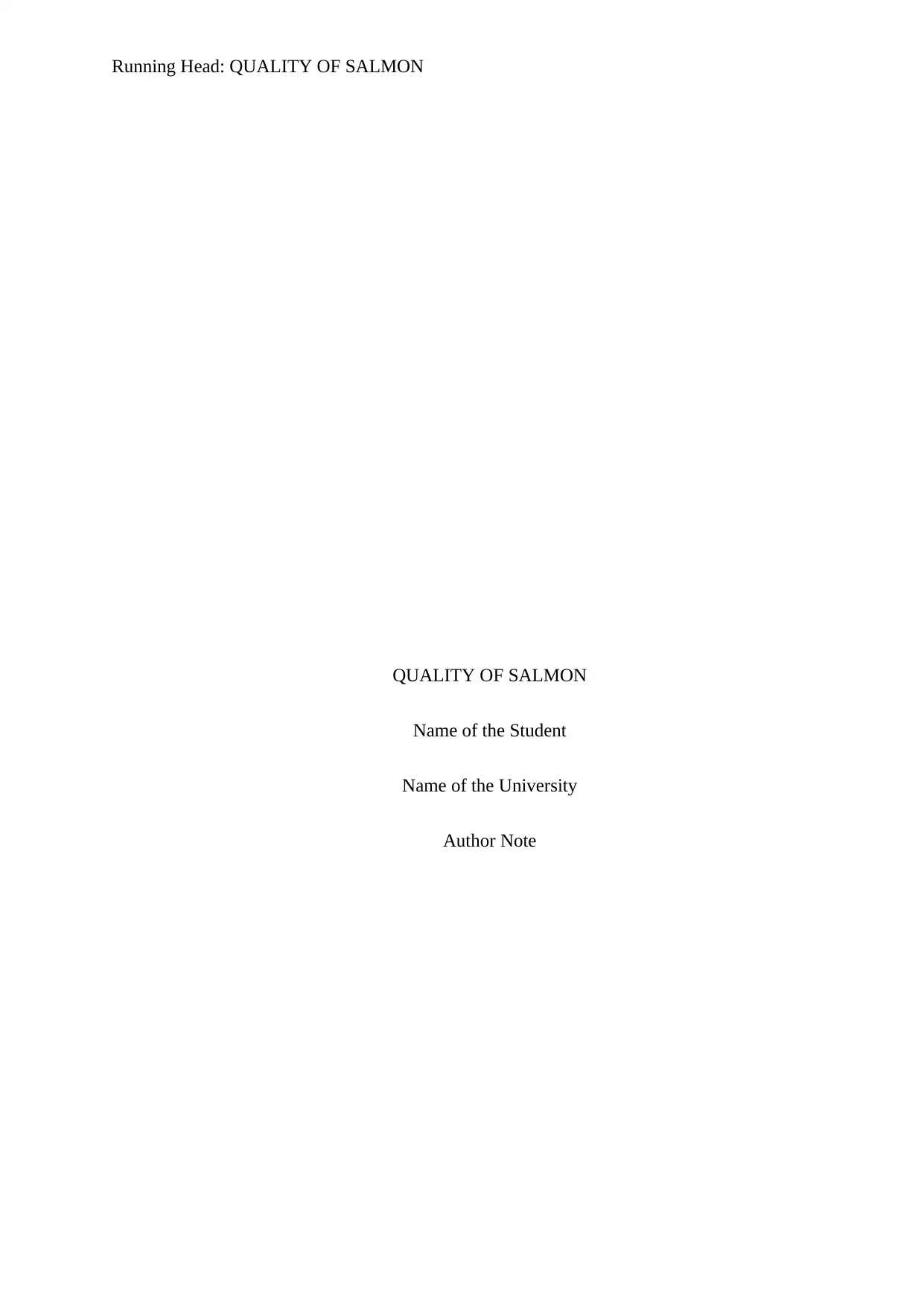
Running Head: QUALITY OF SALMON
QUALITY OF SALMON
Name of the Student
Name of the University
Author Note
QUALITY OF SALMON
Name of the Student
Name of the University
Author Note
Paraphrase This Document
Need a fresh take? Get an instant paraphrase of this document with our AI Paraphraser
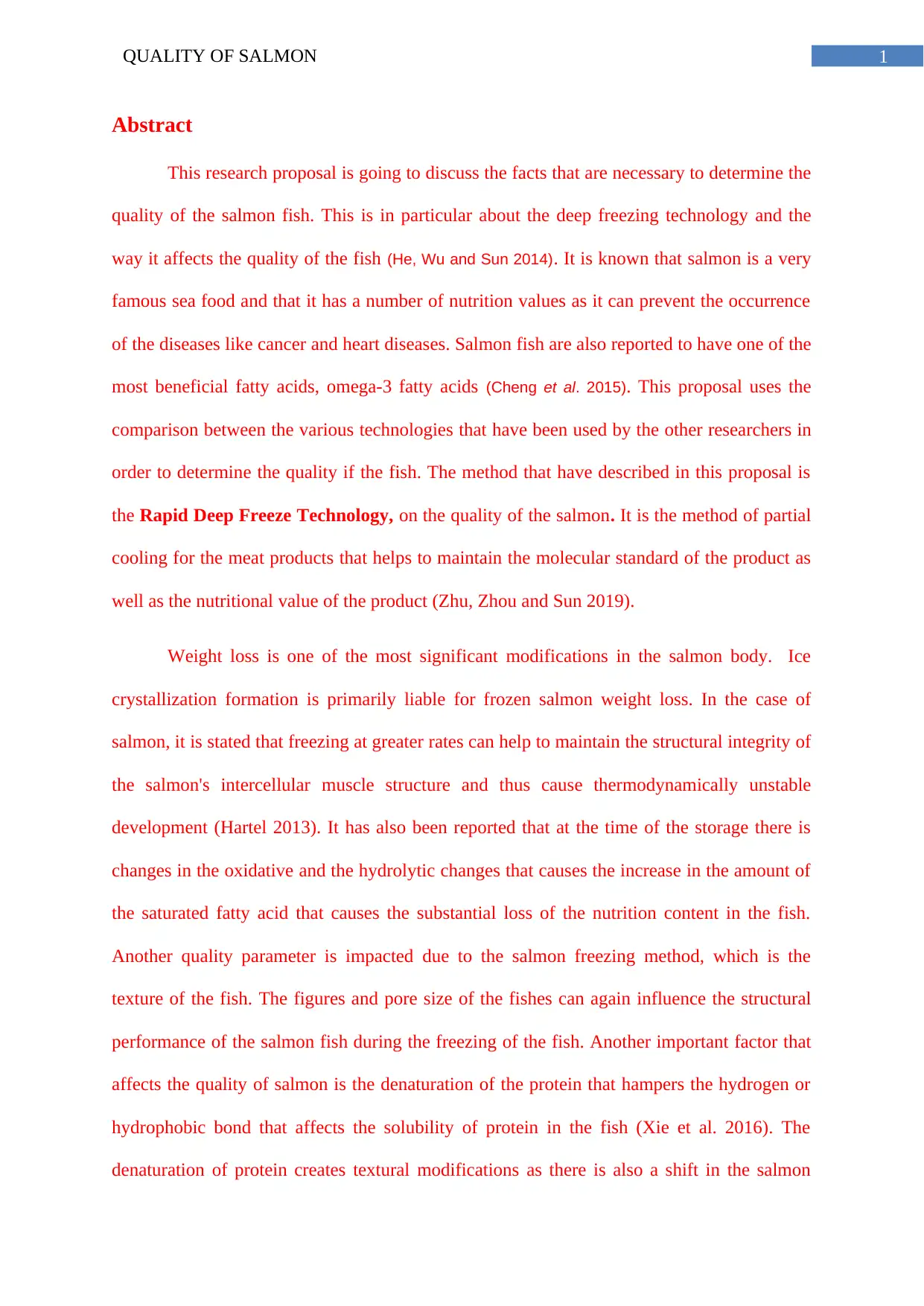
1QUALITY OF SALMON
Abstract
This research proposal is going to discuss the facts that are necessary to determine the
quality of the salmon fish. This is in particular about the deep freezing technology and the
way it affects the quality of the fish (He, Wu and Sun 2014). It is known that salmon is a very
famous sea food and that it has a number of nutrition values as it can prevent the occurrence
of the diseases like cancer and heart diseases. Salmon fish are also reported to have one of the
most beneficial fatty acids, omega-3 fatty acids (Cheng et al. 2015). This proposal uses the
comparison between the various technologies that have been used by the other researchers in
order to determine the quality if the fish. The method that have described in this proposal is
the Rapid Deep Freeze Technology, on the quality of the salmon. It is the method of partial
cooling for the meat products that helps to maintain the molecular standard of the product as
well as the nutritional value of the product (Zhu, Zhou and Sun 2019).
Weight loss is one of the most significant modifications in the salmon body. Ice
crystallization formation is primarily liable for frozen salmon weight loss. In the case of
salmon, it is stated that freezing at greater rates can help to maintain the structural integrity of
the salmon's intercellular muscle structure and thus cause thermodynamically unstable
development (Hartel 2013). It has also been reported that at the time of the storage there is
changes in the oxidative and the hydrolytic changes that causes the increase in the amount of
the saturated fatty acid that causes the substantial loss of the nutrition content in the fish.
Another quality parameter is impacted due to the salmon freezing method, which is the
texture of the fish. The figures and pore size of the fishes can again influence the structural
performance of the salmon fish during the freezing of the fish. Another important factor that
affects the quality of salmon is the denaturation of the protein that hampers the hydrogen or
hydrophobic bond that affects the solubility of protein in the fish (Xie et al. 2016). The
denaturation of protein creates textural modifications as there is also a shift in the salmon
Abstract
This research proposal is going to discuss the facts that are necessary to determine the
quality of the salmon fish. This is in particular about the deep freezing technology and the
way it affects the quality of the fish (He, Wu and Sun 2014). It is known that salmon is a very
famous sea food and that it has a number of nutrition values as it can prevent the occurrence
of the diseases like cancer and heart diseases. Salmon fish are also reported to have one of the
most beneficial fatty acids, omega-3 fatty acids (Cheng et al. 2015). This proposal uses the
comparison between the various technologies that have been used by the other researchers in
order to determine the quality if the fish. The method that have described in this proposal is
the Rapid Deep Freeze Technology, on the quality of the salmon. It is the method of partial
cooling for the meat products that helps to maintain the molecular standard of the product as
well as the nutritional value of the product (Zhu, Zhou and Sun 2019).
Weight loss is one of the most significant modifications in the salmon body. Ice
crystallization formation is primarily liable for frozen salmon weight loss. In the case of
salmon, it is stated that freezing at greater rates can help to maintain the structural integrity of
the salmon's intercellular muscle structure and thus cause thermodynamically unstable
development (Hartel 2013). It has also been reported that at the time of the storage there is
changes in the oxidative and the hydrolytic changes that causes the increase in the amount of
the saturated fatty acid that causes the substantial loss of the nutrition content in the fish.
Another quality parameter is impacted due to the salmon freezing method, which is the
texture of the fish. The figures and pore size of the fishes can again influence the structural
performance of the salmon fish during the freezing of the fish. Another important factor that
affects the quality of salmon is the denaturation of the protein that hampers the hydrogen or
hydrophobic bond that affects the solubility of protein in the fish (Xie et al. 2016). The
denaturation of protein creates textural modifications as there is also a shift in the salmon
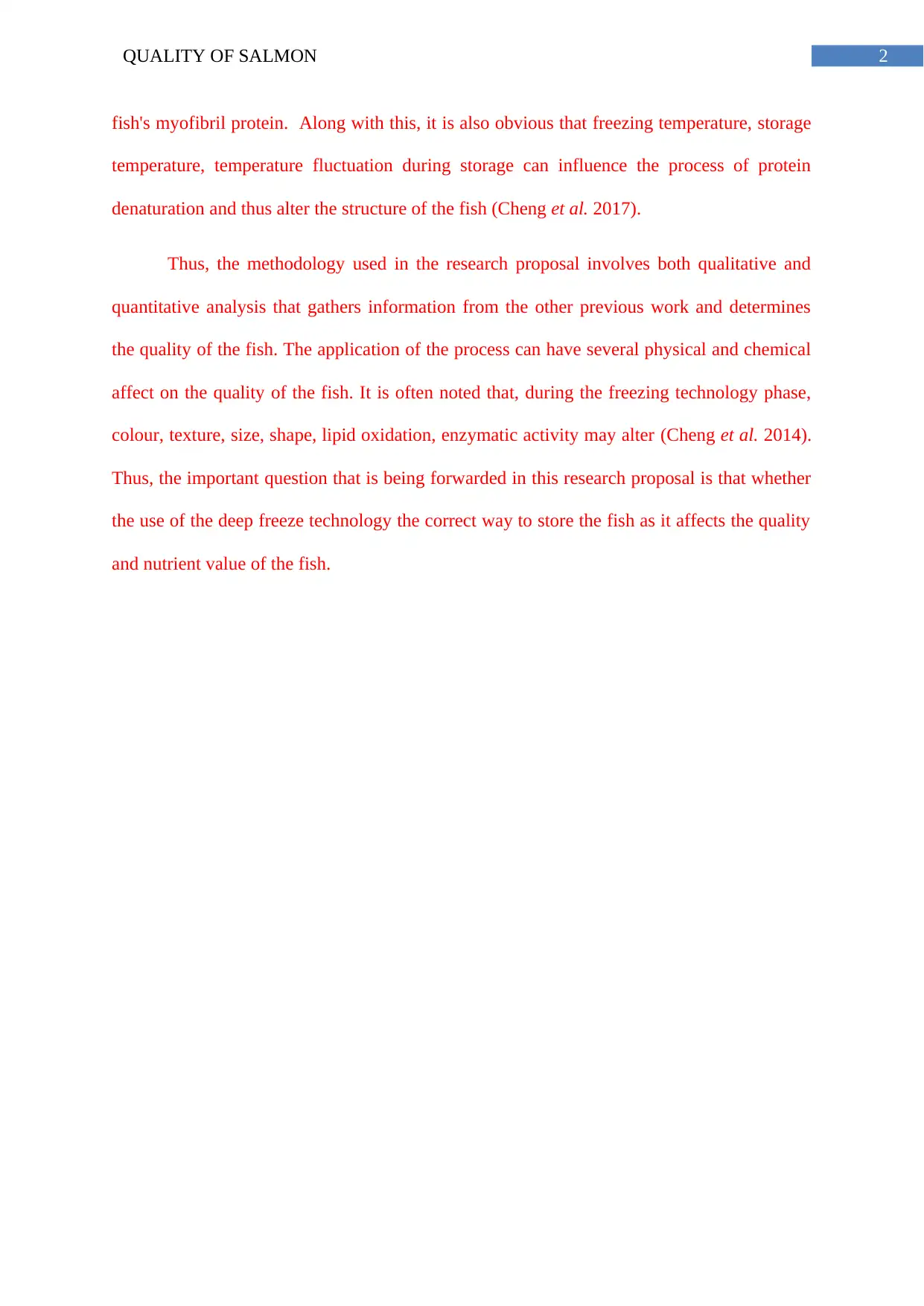
2QUALITY OF SALMON
fish's myofibril protein. Along with this, it is also obvious that freezing temperature, storage
temperature, temperature fluctuation during storage can influence the process of protein
denaturation and thus alter the structure of the fish (Cheng et al. 2017).
Thus, the methodology used in the research proposal involves both qualitative and
quantitative analysis that gathers information from the other previous work and determines
the quality of the fish. The application of the process can have several physical and chemical
affect on the quality of the fish. It is often noted that, during the freezing technology phase,
colour, texture, size, shape, lipid oxidation, enzymatic activity may alter (Cheng et al. 2014).
Thus, the important question that is being forwarded in this research proposal is that whether
the use of the deep freeze technology the correct way to store the fish as it affects the quality
and nutrient value of the fish.
fish's myofibril protein. Along with this, it is also obvious that freezing temperature, storage
temperature, temperature fluctuation during storage can influence the process of protein
denaturation and thus alter the structure of the fish (Cheng et al. 2017).
Thus, the methodology used in the research proposal involves both qualitative and
quantitative analysis that gathers information from the other previous work and determines
the quality of the fish. The application of the process can have several physical and chemical
affect on the quality of the fish. It is often noted that, during the freezing technology phase,
colour, texture, size, shape, lipid oxidation, enzymatic activity may alter (Cheng et al. 2014).
Thus, the important question that is being forwarded in this research proposal is that whether
the use of the deep freeze technology the correct way to store the fish as it affects the quality
and nutrient value of the fish.
⊘ This is a preview!⊘
Do you want full access?
Subscribe today to unlock all pages.

Trusted by 1+ million students worldwide
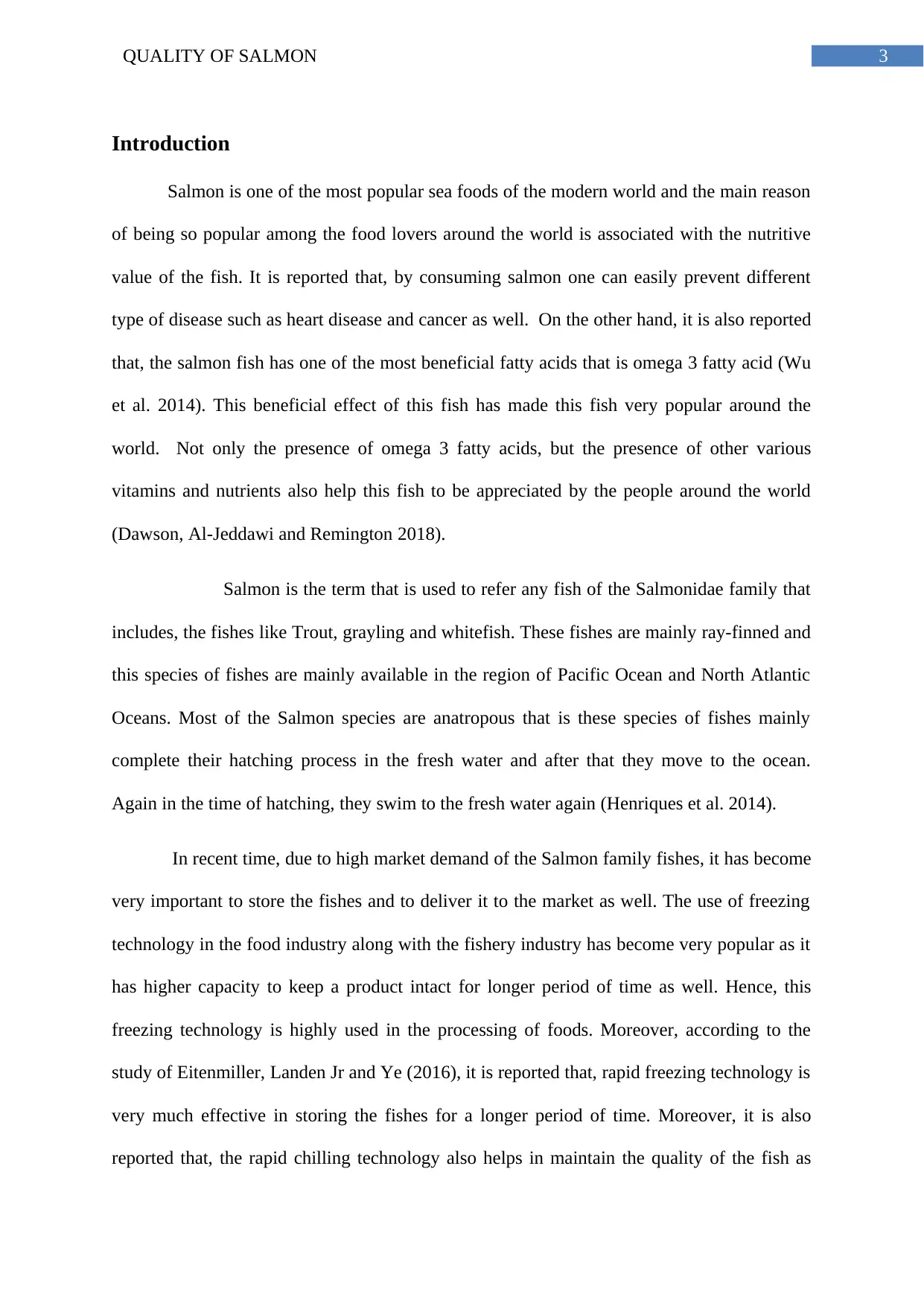
3QUALITY OF SALMON
Introduction
Salmon is one of the most popular sea foods of the modern world and the main reason
of being so popular among the food lovers around the world is associated with the nutritive
value of the fish. It is reported that, by consuming salmon one can easily prevent different
type of disease such as heart disease and cancer as well. On the other hand, it is also reported
that, the salmon fish has one of the most beneficial fatty acids that is omega 3 fatty acid (Wu
et al. 2014). This beneficial effect of this fish has made this fish very popular around the
world. Not only the presence of omega 3 fatty acids, but the presence of other various
vitamins and nutrients also help this fish to be appreciated by the people around the world
(Dawson, Al-Jeddawi and Remington 2018).
Salmon is the term that is used to refer any fish of the Salmonidae family that
includes, the fishes like Trout, grayling and whitefish. These fishes are mainly ray-finned and
this species of fishes are mainly available in the region of Pacific Ocean and North Atlantic
Oceans. Most of the Salmon species are anatropous that is these species of fishes mainly
complete their hatching process in the fresh water and after that they move to the ocean.
Again in the time of hatching, they swim to the fresh water again (Henriques et al. 2014).
In recent time, due to high market demand of the Salmon family fishes, it has become
very important to store the fishes and to deliver it to the market as well. The use of freezing
technology in the food industry along with the fishery industry has become very popular as it
has higher capacity to keep a product intact for longer period of time as well. Hence, this
freezing technology is highly used in the processing of foods. Moreover, according to the
study of Eitenmiller, Landen Jr and Ye (2016), it is reported that, rapid freezing technology is
very much effective in storing the fishes for a longer period of time. Moreover, it is also
reported that, the rapid chilling technology also helps in maintain the quality of the fish as
Introduction
Salmon is one of the most popular sea foods of the modern world and the main reason
of being so popular among the food lovers around the world is associated with the nutritive
value of the fish. It is reported that, by consuming salmon one can easily prevent different
type of disease such as heart disease and cancer as well. On the other hand, it is also reported
that, the salmon fish has one of the most beneficial fatty acids that is omega 3 fatty acid (Wu
et al. 2014). This beneficial effect of this fish has made this fish very popular around the
world. Not only the presence of omega 3 fatty acids, but the presence of other various
vitamins and nutrients also help this fish to be appreciated by the people around the world
(Dawson, Al-Jeddawi and Remington 2018).
Salmon is the term that is used to refer any fish of the Salmonidae family that
includes, the fishes like Trout, grayling and whitefish. These fishes are mainly ray-finned and
this species of fishes are mainly available in the region of Pacific Ocean and North Atlantic
Oceans. Most of the Salmon species are anatropous that is these species of fishes mainly
complete their hatching process in the fresh water and after that they move to the ocean.
Again in the time of hatching, they swim to the fresh water again (Henriques et al. 2014).
In recent time, due to high market demand of the Salmon family fishes, it has become
very important to store the fishes and to deliver it to the market as well. The use of freezing
technology in the food industry along with the fishery industry has become very popular as it
has higher capacity to keep a product intact for longer period of time as well. Hence, this
freezing technology is highly used in the processing of foods. Moreover, according to the
study of Eitenmiller, Landen Jr and Ye (2016), it is reported that, rapid freezing technology is
very much effective in storing the fishes for a longer period of time. Moreover, it is also
reported that, the rapid chilling technology also helps in maintain the quality of the fish as
Paraphrase This Document
Need a fresh take? Get an instant paraphrase of this document with our AI Paraphraser
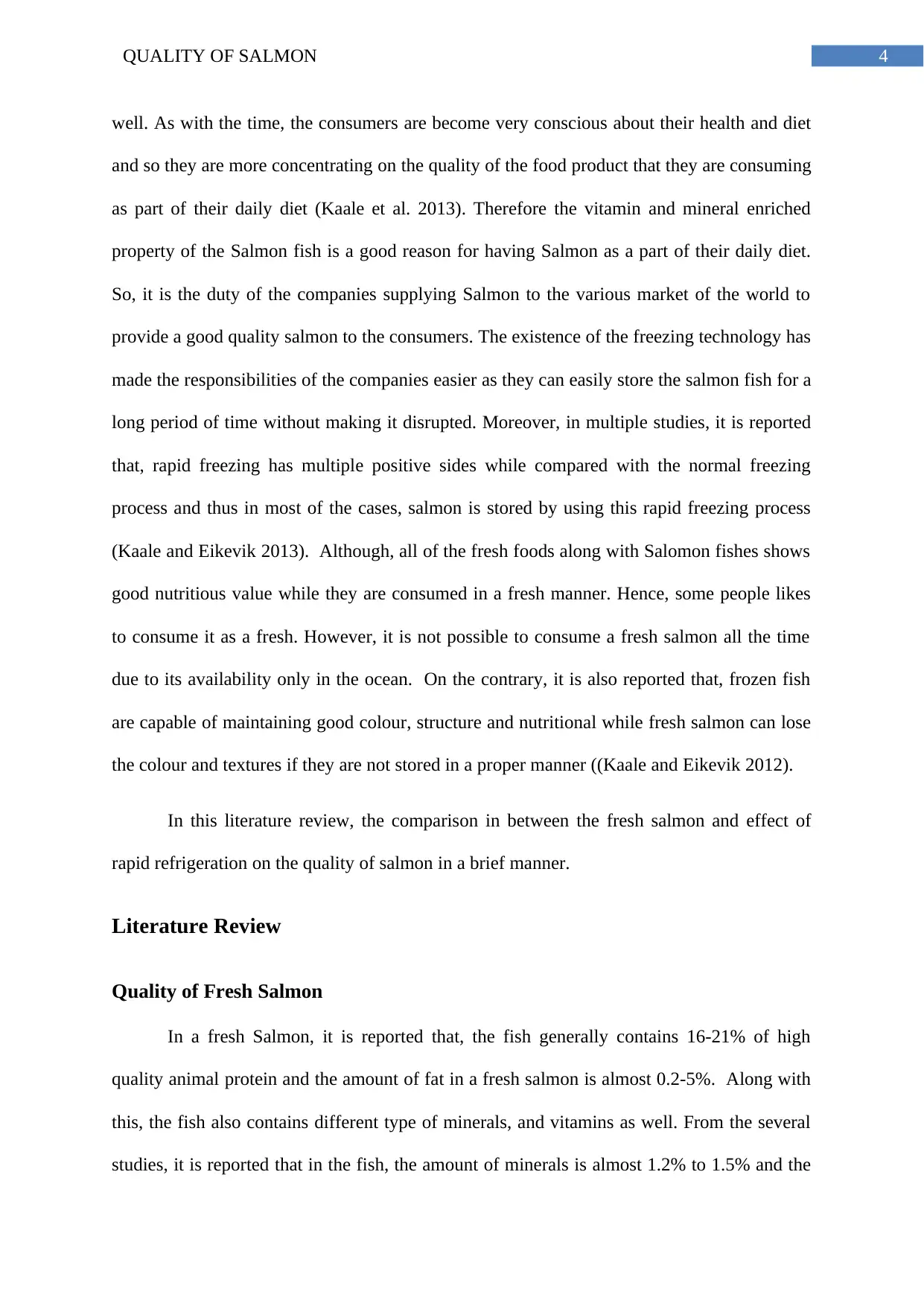
4QUALITY OF SALMON
well. As with the time, the consumers are become very conscious about their health and diet
and so they are more concentrating on the quality of the food product that they are consuming
as part of their daily diet (Kaale et al. 2013). Therefore the vitamin and mineral enriched
property of the Salmon fish is a good reason for having Salmon as a part of their daily diet.
So, it is the duty of the companies supplying Salmon to the various market of the world to
provide a good quality salmon to the consumers. The existence of the freezing technology has
made the responsibilities of the companies easier as they can easily store the salmon fish for a
long period of time without making it disrupted. Moreover, in multiple studies, it is reported
that, rapid freezing has multiple positive sides while compared with the normal freezing
process and thus in most of the cases, salmon is stored by using this rapid freezing process
(Kaale and Eikevik 2013). Although, all of the fresh foods along with Salomon fishes shows
good nutritious value while they are consumed in a fresh manner. Hence, some people likes
to consume it as a fresh. However, it is not possible to consume a fresh salmon all the time
due to its availability only in the ocean. On the contrary, it is also reported that, frozen fish
are capable of maintaining good colour, structure and nutritional while fresh salmon can lose
the colour and textures if they are not stored in a proper manner ((Kaale and Eikevik 2012).
In this literature review, the comparison in between the fresh salmon and effect of
rapid refrigeration on the quality of salmon in a brief manner.
Literature Review
Quality of Fresh Salmon
In a fresh Salmon, it is reported that, the fish generally contains 16-21% of high
quality animal protein and the amount of fat in a fresh salmon is almost 0.2-5%. Along with
this, the fish also contains different type of minerals, and vitamins as well. From the several
studies, it is reported that in the fish, the amount of minerals is almost 1.2% to 1.5% and the
well. As with the time, the consumers are become very conscious about their health and diet
and so they are more concentrating on the quality of the food product that they are consuming
as part of their daily diet (Kaale et al. 2013). Therefore the vitamin and mineral enriched
property of the Salmon fish is a good reason for having Salmon as a part of their daily diet.
So, it is the duty of the companies supplying Salmon to the various market of the world to
provide a good quality salmon to the consumers. The existence of the freezing technology has
made the responsibilities of the companies easier as they can easily store the salmon fish for a
long period of time without making it disrupted. Moreover, in multiple studies, it is reported
that, rapid freezing has multiple positive sides while compared with the normal freezing
process and thus in most of the cases, salmon is stored by using this rapid freezing process
(Kaale and Eikevik 2013). Although, all of the fresh foods along with Salomon fishes shows
good nutritious value while they are consumed in a fresh manner. Hence, some people likes
to consume it as a fresh. However, it is not possible to consume a fresh salmon all the time
due to its availability only in the ocean. On the contrary, it is also reported that, frozen fish
are capable of maintaining good colour, structure and nutritional while fresh salmon can lose
the colour and textures if they are not stored in a proper manner ((Kaale and Eikevik 2012).
In this literature review, the comparison in between the fresh salmon and effect of
rapid refrigeration on the quality of salmon in a brief manner.
Literature Review
Quality of Fresh Salmon
In a fresh Salmon, it is reported that, the fish generally contains 16-21% of high
quality animal protein and the amount of fat in a fresh salmon is almost 0.2-5%. Along with
this, the fish also contains different type of minerals, and vitamins as well. From the several
studies, it is reported that in the fish, the amount of minerals is almost 1.2% to 1.5% and the
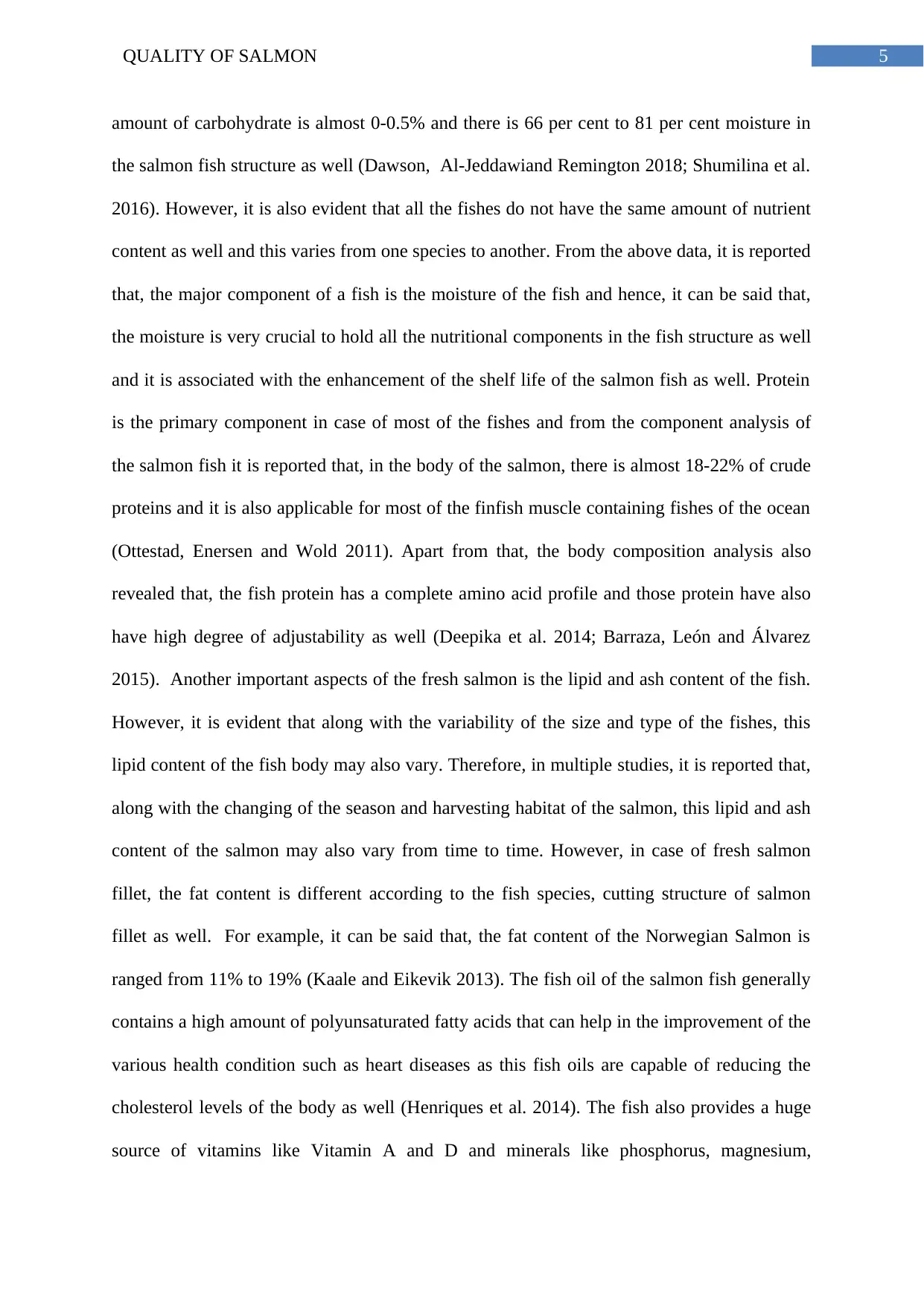
5QUALITY OF SALMON
amount of carbohydrate is almost 0-0.5% and there is 66 per cent to 81 per cent moisture in
the salmon fish structure as well (Dawson, Al-Jeddawiand Remington 2018; Shumilina et al.
2016). However, it is also evident that all the fishes do not have the same amount of nutrient
content as well and this varies from one species to another. From the above data, it is reported
that, the major component of a fish is the moisture of the fish and hence, it can be said that,
the moisture is very crucial to hold all the nutritional components in the fish structure as well
and it is associated with the enhancement of the shelf life of the salmon fish as well. Protein
is the primary component in case of most of the fishes and from the component analysis of
the salmon fish it is reported that, in the body of the salmon, there is almost 18-22% of crude
proteins and it is also applicable for most of the finfish muscle containing fishes of the ocean
(Ottestad, Enersen and Wold 2011). Apart from that, the body composition analysis also
revealed that, the fish protein has a complete amino acid profile and those protein have also
have high degree of adjustability as well (Deepika et al. 2014; Barraza, León and Álvarez
2015). Another important aspects of the fresh salmon is the lipid and ash content of the fish.
However, it is evident that along with the variability of the size and type of the fishes, this
lipid content of the fish body may also vary. Therefore, in multiple studies, it is reported that,
along with the changing of the season and harvesting habitat of the salmon, this lipid and ash
content of the salmon may also vary from time to time. However, in case of fresh salmon
fillet, the fat content is different according to the fish species, cutting structure of salmon
fillet as well. For example, it can be said that, the fat content of the Norwegian Salmon is
ranged from 11% to 19% (Kaale and Eikevik 2013). The fish oil of the salmon fish generally
contains a high amount of polyunsaturated fatty acids that can help in the improvement of the
various health condition such as heart diseases as this fish oils are capable of reducing the
cholesterol levels of the body as well (Henriques et al. 2014). The fish also provides a huge
source of vitamins like Vitamin A and D and minerals like phosphorus, magnesium,
amount of carbohydrate is almost 0-0.5% and there is 66 per cent to 81 per cent moisture in
the salmon fish structure as well (Dawson, Al-Jeddawiand Remington 2018; Shumilina et al.
2016). However, it is also evident that all the fishes do not have the same amount of nutrient
content as well and this varies from one species to another. From the above data, it is reported
that, the major component of a fish is the moisture of the fish and hence, it can be said that,
the moisture is very crucial to hold all the nutritional components in the fish structure as well
and it is associated with the enhancement of the shelf life of the salmon fish as well. Protein
is the primary component in case of most of the fishes and from the component analysis of
the salmon fish it is reported that, in the body of the salmon, there is almost 18-22% of crude
proteins and it is also applicable for most of the finfish muscle containing fishes of the ocean
(Ottestad, Enersen and Wold 2011). Apart from that, the body composition analysis also
revealed that, the fish protein has a complete amino acid profile and those protein have also
have high degree of adjustability as well (Deepika et al. 2014; Barraza, León and Álvarez
2015). Another important aspects of the fresh salmon is the lipid and ash content of the fish.
However, it is evident that along with the variability of the size and type of the fishes, this
lipid content of the fish body may also vary. Therefore, in multiple studies, it is reported that,
along with the changing of the season and harvesting habitat of the salmon, this lipid and ash
content of the salmon may also vary from time to time. However, in case of fresh salmon
fillet, the fat content is different according to the fish species, cutting structure of salmon
fillet as well. For example, it can be said that, the fat content of the Norwegian Salmon is
ranged from 11% to 19% (Kaale and Eikevik 2013). The fish oil of the salmon fish generally
contains a high amount of polyunsaturated fatty acids that can help in the improvement of the
various health condition such as heart diseases as this fish oils are capable of reducing the
cholesterol levels of the body as well (Henriques et al. 2014). The fish also provides a huge
source of vitamins like Vitamin A and D and minerals like phosphorus, magnesium,
⊘ This is a preview!⊘
Do you want full access?
Subscribe today to unlock all pages.

Trusted by 1+ million students worldwide
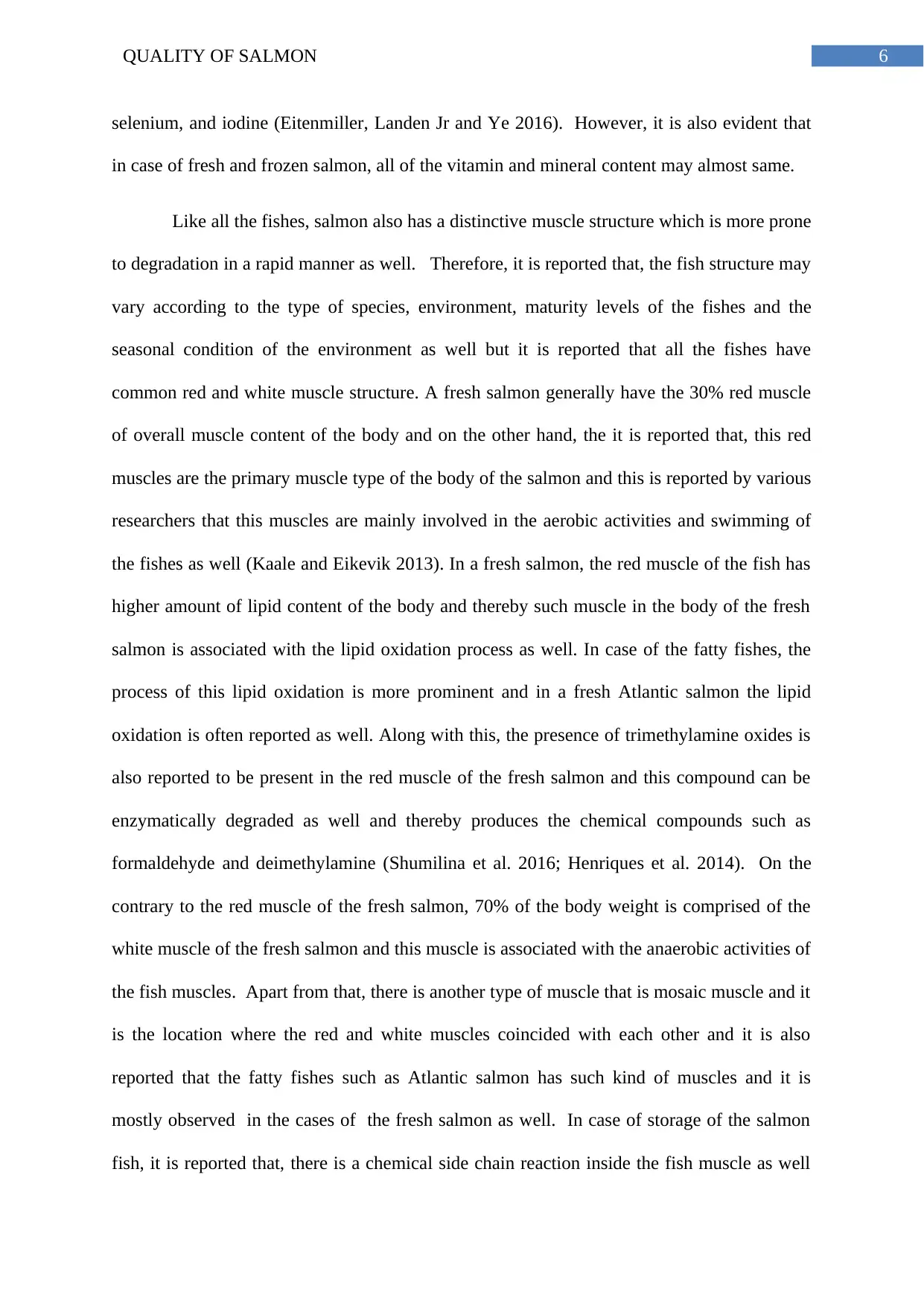
6QUALITY OF SALMON
selenium, and iodine (Eitenmiller, Landen Jr and Ye 2016). However, it is also evident that
in case of fresh and frozen salmon, all of the vitamin and mineral content may almost same.
Like all the fishes, salmon also has a distinctive muscle structure which is more prone
to degradation in a rapid manner as well. Therefore, it is reported that, the fish structure may
vary according to the type of species, environment, maturity levels of the fishes and the
seasonal condition of the environment as well but it is reported that all the fishes have
common red and white muscle structure. A fresh salmon generally have the 30% red muscle
of overall muscle content of the body and on the other hand, the it is reported that, this red
muscles are the primary muscle type of the body of the salmon and this is reported by various
researchers that this muscles are mainly involved in the aerobic activities and swimming of
the fishes as well (Kaale and Eikevik 2013). In a fresh salmon, the red muscle of the fish has
higher amount of lipid content of the body and thereby such muscle in the body of the fresh
salmon is associated with the lipid oxidation process as well. In case of the fatty fishes, the
process of this lipid oxidation is more prominent and in a fresh Atlantic salmon the lipid
oxidation is often reported as well. Along with this, the presence of trimethylamine oxides is
also reported to be present in the red muscle of the fresh salmon and this compound can be
enzymatically degraded as well and thereby produces the chemical compounds such as
formaldehyde and deimethylamine (Shumilina et al. 2016; Henriques et al. 2014). On the
contrary to the red muscle of the fresh salmon, 70% of the body weight is comprised of the
white muscle of the fresh salmon and this muscle is associated with the anaerobic activities of
the fish muscles. Apart from that, there is another type of muscle that is mosaic muscle and it
is the location where the red and white muscles coincided with each other and it is also
reported that the fatty fishes such as Atlantic salmon has such kind of muscles and it is
mostly observed in the cases of the fresh salmon as well. In case of storage of the salmon
fish, it is reported that, there is a chemical side chain reaction inside the fish muscle as well
selenium, and iodine (Eitenmiller, Landen Jr and Ye 2016). However, it is also evident that
in case of fresh and frozen salmon, all of the vitamin and mineral content may almost same.
Like all the fishes, salmon also has a distinctive muscle structure which is more prone
to degradation in a rapid manner as well. Therefore, it is reported that, the fish structure may
vary according to the type of species, environment, maturity levels of the fishes and the
seasonal condition of the environment as well but it is reported that all the fishes have
common red and white muscle structure. A fresh salmon generally have the 30% red muscle
of overall muscle content of the body and on the other hand, the it is reported that, this red
muscles are the primary muscle type of the body of the salmon and this is reported by various
researchers that this muscles are mainly involved in the aerobic activities and swimming of
the fishes as well (Kaale and Eikevik 2013). In a fresh salmon, the red muscle of the fish has
higher amount of lipid content of the body and thereby such muscle in the body of the fresh
salmon is associated with the lipid oxidation process as well. In case of the fatty fishes, the
process of this lipid oxidation is more prominent and in a fresh Atlantic salmon the lipid
oxidation is often reported as well. Along with this, the presence of trimethylamine oxides is
also reported to be present in the red muscle of the fresh salmon and this compound can be
enzymatically degraded as well and thereby produces the chemical compounds such as
formaldehyde and deimethylamine (Shumilina et al. 2016; Henriques et al. 2014). On the
contrary to the red muscle of the fresh salmon, 70% of the body weight is comprised of the
white muscle of the fresh salmon and this muscle is associated with the anaerobic activities of
the fish muscles. Apart from that, there is another type of muscle that is mosaic muscle and it
is the location where the red and white muscles coincided with each other and it is also
reported that the fatty fishes such as Atlantic salmon has such kind of muscles and it is
mostly observed in the cases of the fresh salmon as well. In case of storage of the salmon
fish, it is reported that, there is a chemical side chain reaction inside the fish muscle as well
Paraphrase This Document
Need a fresh take? Get an instant paraphrase of this document with our AI Paraphraser
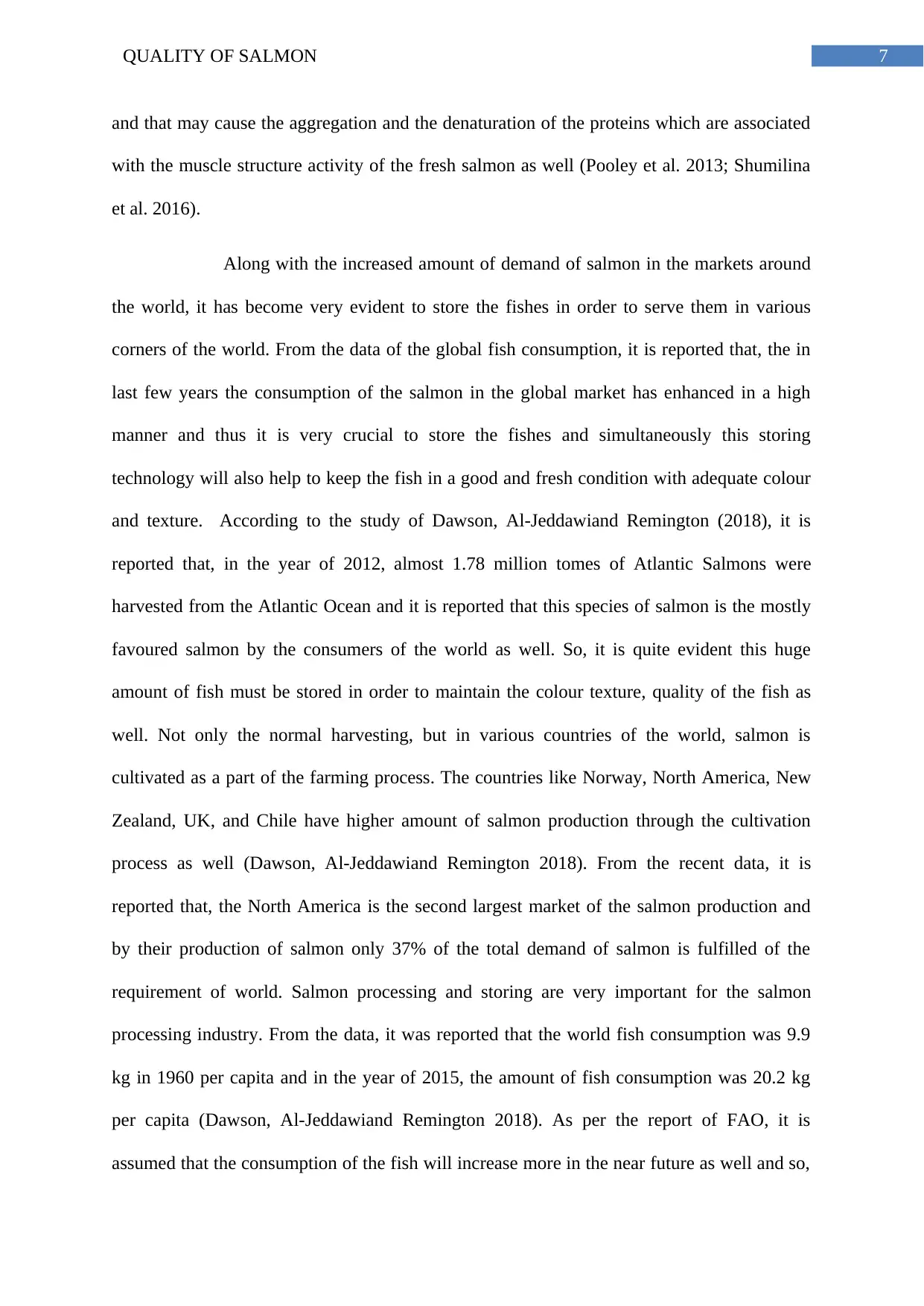
7QUALITY OF SALMON
and that may cause the aggregation and the denaturation of the proteins which are associated
with the muscle structure activity of the fresh salmon as well (Pooley et al. 2013; Shumilina
et al. 2016).
Along with the increased amount of demand of salmon in the markets around
the world, it has become very evident to store the fishes in order to serve them in various
corners of the world. From the data of the global fish consumption, it is reported that, the in
last few years the consumption of the salmon in the global market has enhanced in a high
manner and thus it is very crucial to store the fishes and simultaneously this storing
technology will also help to keep the fish in a good and fresh condition with adequate colour
and texture. According to the study of Dawson, Al-Jeddawiand Remington (2018), it is
reported that, in the year of 2012, almost 1.78 million tomes of Atlantic Salmons were
harvested from the Atlantic Ocean and it is reported that this species of salmon is the mostly
favoured salmon by the consumers of the world as well. So, it is quite evident this huge
amount of fish must be stored in order to maintain the colour texture, quality of the fish as
well. Not only the normal harvesting, but in various countries of the world, salmon is
cultivated as a part of the farming process. The countries like Norway, North America, New
Zealand, UK, and Chile have higher amount of salmon production through the cultivation
process as well (Dawson, Al-Jeddawiand Remington 2018). From the recent data, it is
reported that, the North America is the second largest market of the salmon production and
by their production of salmon only 37% of the total demand of salmon is fulfilled of the
requirement of world. Salmon processing and storing are very important for the salmon
processing industry. From the data, it was reported that the world fish consumption was 9.9
kg in 1960 per capita and in the year of 2015, the amount of fish consumption was 20.2 kg
per capita (Dawson, Al-Jeddawiand Remington 2018). As per the report of FAO, it is
assumed that the consumption of the fish will increase more in the near future as well and so,
and that may cause the aggregation and the denaturation of the proteins which are associated
with the muscle structure activity of the fresh salmon as well (Pooley et al. 2013; Shumilina
et al. 2016).
Along with the increased amount of demand of salmon in the markets around
the world, it has become very evident to store the fishes in order to serve them in various
corners of the world. From the data of the global fish consumption, it is reported that, the in
last few years the consumption of the salmon in the global market has enhanced in a high
manner and thus it is very crucial to store the fishes and simultaneously this storing
technology will also help to keep the fish in a good and fresh condition with adequate colour
and texture. According to the study of Dawson, Al-Jeddawiand Remington (2018), it is
reported that, in the year of 2012, almost 1.78 million tomes of Atlantic Salmons were
harvested from the Atlantic Ocean and it is reported that this species of salmon is the mostly
favoured salmon by the consumers of the world as well. So, it is quite evident this huge
amount of fish must be stored in order to maintain the colour texture, quality of the fish as
well. Not only the normal harvesting, but in various countries of the world, salmon is
cultivated as a part of the farming process. The countries like Norway, North America, New
Zealand, UK, and Chile have higher amount of salmon production through the cultivation
process as well (Dawson, Al-Jeddawiand Remington 2018). From the recent data, it is
reported that, the North America is the second largest market of the salmon production and
by their production of salmon only 37% of the total demand of salmon is fulfilled of the
requirement of world. Salmon processing and storing are very important for the salmon
processing industry. From the data, it was reported that the world fish consumption was 9.9
kg in 1960 per capita and in the year of 2015, the amount of fish consumption was 20.2 kg
per capita (Dawson, Al-Jeddawiand Remington 2018). As per the report of FAO, it is
assumed that the consumption of the fish will increase more in the near future as well and so,
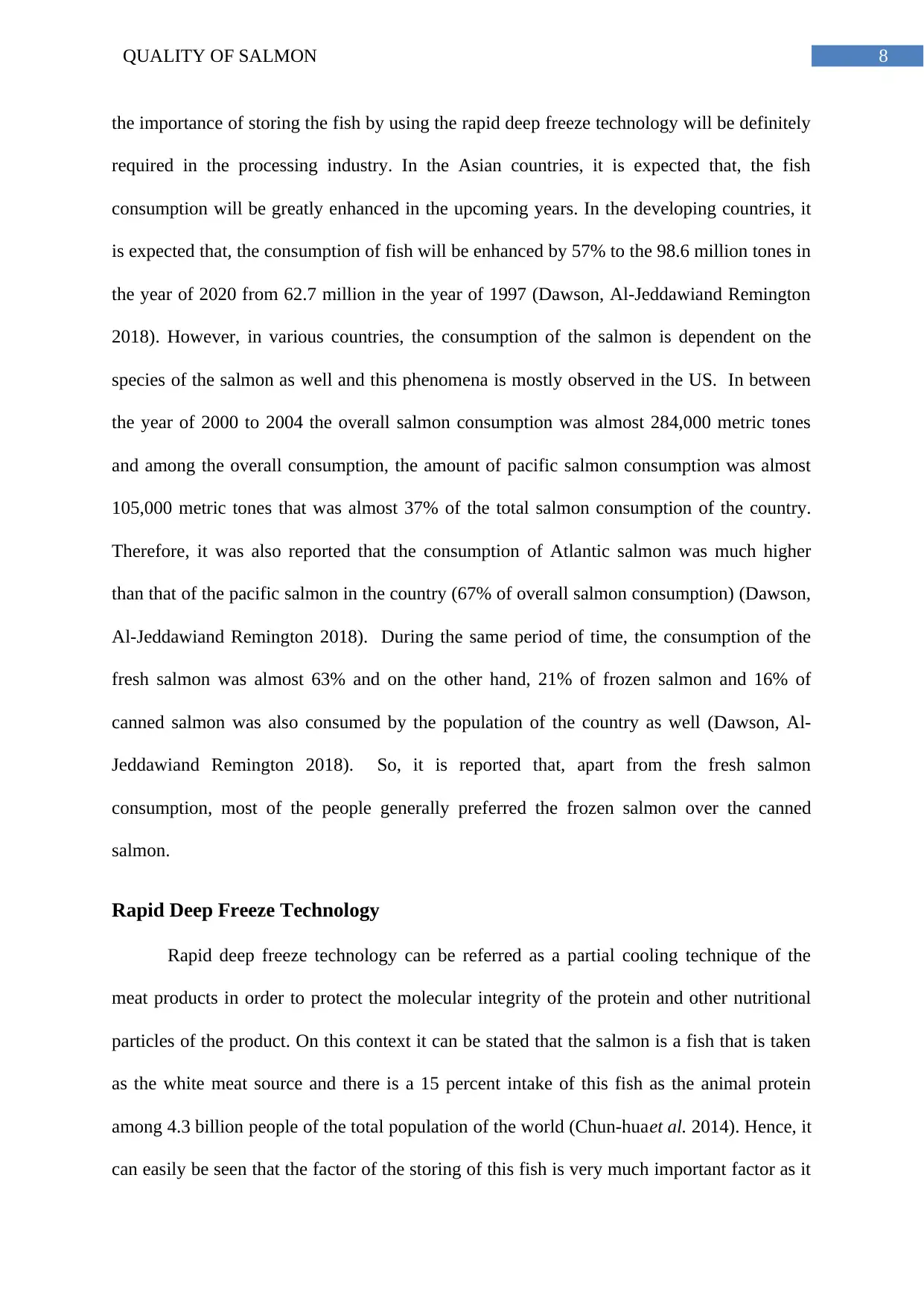
8QUALITY OF SALMON
the importance of storing the fish by using the rapid deep freeze technology will be definitely
required in the processing industry. In the Asian countries, it is expected that, the fish
consumption will be greatly enhanced in the upcoming years. In the developing countries, it
is expected that, the consumption of fish will be enhanced by 57% to the 98.6 million tones in
the year of 2020 from 62.7 million in the year of 1997 (Dawson, Al-Jeddawiand Remington
2018). However, in various countries, the consumption of the salmon is dependent on the
species of the salmon as well and this phenomena is mostly observed in the US. In between
the year of 2000 to 2004 the overall salmon consumption was almost 284,000 metric tones
and among the overall consumption, the amount of pacific salmon consumption was almost
105,000 metric tones that was almost 37% of the total salmon consumption of the country.
Therefore, it was also reported that the consumption of Atlantic salmon was much higher
than that of the pacific salmon in the country (67% of overall salmon consumption) (Dawson,
Al-Jeddawiand Remington 2018). During the same period of time, the consumption of the
fresh salmon was almost 63% and on the other hand, 21% of frozen salmon and 16% of
canned salmon was also consumed by the population of the country as well (Dawson, Al-
Jeddawiand Remington 2018). So, it is reported that, apart from the fresh salmon
consumption, most of the people generally preferred the frozen salmon over the canned
salmon.
Rapid Deep Freeze Technology
Rapid deep freeze technology can be referred as a partial cooling technique of the
meat products in order to protect the molecular integrity of the protein and other nutritional
particles of the product. On this context it can be stated that the salmon is a fish that is taken
as the white meat source and there is a 15 percent intake of this fish as the animal protein
among 4.3 billion people of the total population of the world (Chun-huaet al. 2014). Hence, it
can easily be seen that the factor of the storing of this fish is very much important factor as it
the importance of storing the fish by using the rapid deep freeze technology will be definitely
required in the processing industry. In the Asian countries, it is expected that, the fish
consumption will be greatly enhanced in the upcoming years. In the developing countries, it
is expected that, the consumption of fish will be enhanced by 57% to the 98.6 million tones in
the year of 2020 from 62.7 million in the year of 1997 (Dawson, Al-Jeddawiand Remington
2018). However, in various countries, the consumption of the salmon is dependent on the
species of the salmon as well and this phenomena is mostly observed in the US. In between
the year of 2000 to 2004 the overall salmon consumption was almost 284,000 metric tones
and among the overall consumption, the amount of pacific salmon consumption was almost
105,000 metric tones that was almost 37% of the total salmon consumption of the country.
Therefore, it was also reported that the consumption of Atlantic salmon was much higher
than that of the pacific salmon in the country (67% of overall salmon consumption) (Dawson,
Al-Jeddawiand Remington 2018). During the same period of time, the consumption of the
fresh salmon was almost 63% and on the other hand, 21% of frozen salmon and 16% of
canned salmon was also consumed by the population of the country as well (Dawson, Al-
Jeddawiand Remington 2018). So, it is reported that, apart from the fresh salmon
consumption, most of the people generally preferred the frozen salmon over the canned
salmon.
Rapid Deep Freeze Technology
Rapid deep freeze technology can be referred as a partial cooling technique of the
meat products in order to protect the molecular integrity of the protein and other nutritional
particles of the product. On this context it can be stated that the salmon is a fish that is taken
as the white meat source and there is a 15 percent intake of this fish as the animal protein
among 4.3 billion people of the total population of the world (Chun-huaet al. 2014). Hence, it
can easily be seen that the factor of the storing of this fish is very much important factor as it
⊘ This is a preview!⊘
Do you want full access?
Subscribe today to unlock all pages.

Trusted by 1+ million students worldwide
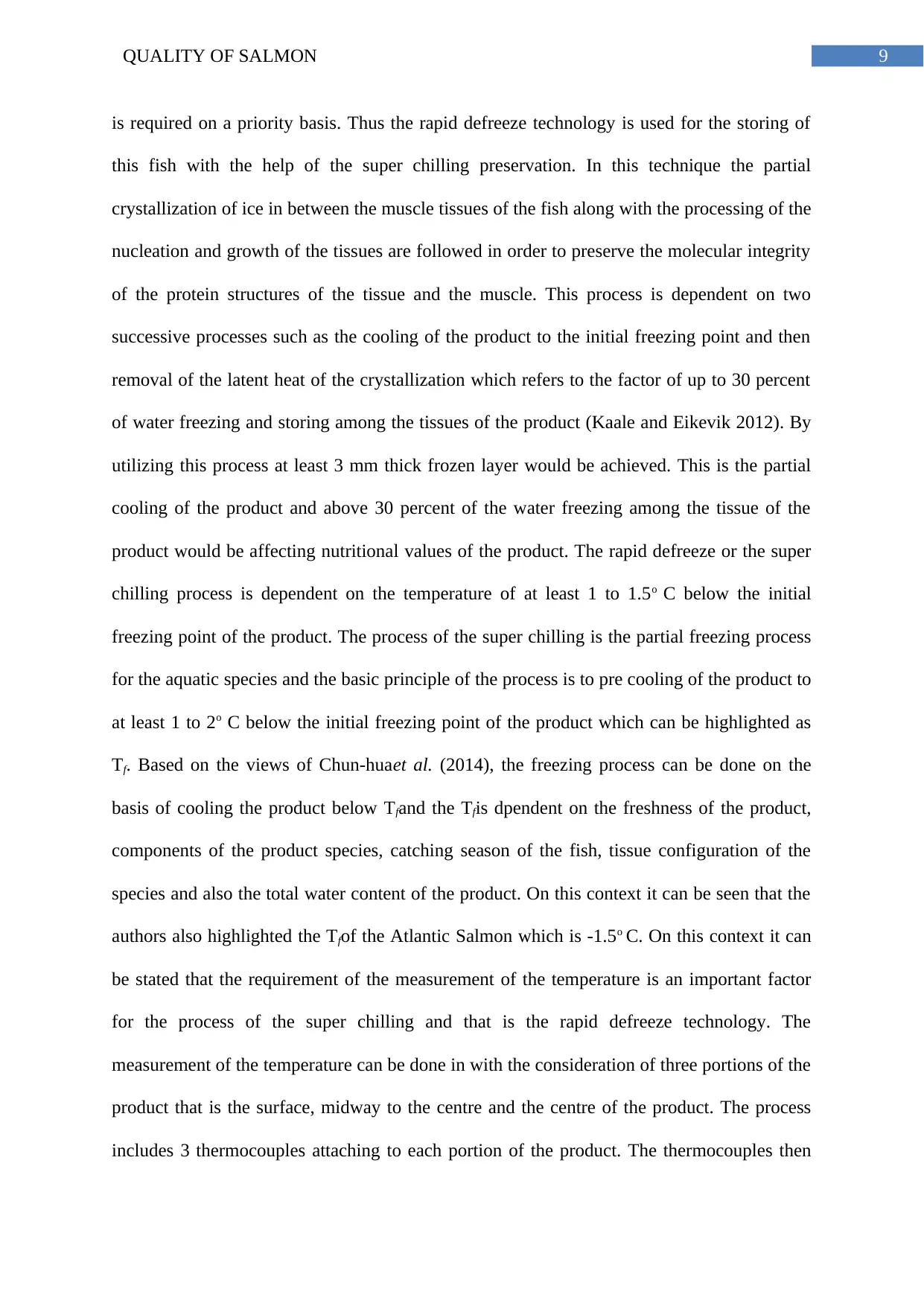
9QUALITY OF SALMON
is required on a priority basis. Thus the rapid defreeze technology is used for the storing of
this fish with the help of the super chilling preservation. In this technique the partial
crystallization of ice in between the muscle tissues of the fish along with the processing of the
nucleation and growth of the tissues are followed in order to preserve the molecular integrity
of the protein structures of the tissue and the muscle. This process is dependent on two
successive processes such as the cooling of the product to the initial freezing point and then
removal of the latent heat of the crystallization which refers to the factor of up to 30 percent
of water freezing and storing among the tissues of the product (Kaale and Eikevik 2012). By
utilizing this process at least 3 mm thick frozen layer would be achieved. This is the partial
cooling of the product and above 30 percent of the water freezing among the tissue of the
product would be affecting nutritional values of the product. The rapid defreeze or the super
chilling process is dependent on the temperature of at least 1 to 1.5o C below the initial
freezing point of the product. The process of the super chilling is the partial freezing process
for the aquatic species and the basic principle of the process is to pre cooling of the product to
at least 1 to 2o C below the initial freezing point of the product which can be highlighted as
Tf. Based on the views of Chun-huaet al. (2014), the freezing process can be done on the
basis of cooling the product below Tfand the Tfis dpendent on the freshness of the product,
components of the product species, catching season of the fish, tissue configuration of the
species and also the total water content of the product. On this context it can be seen that the
authors also highlighted the Tfof the Atlantic Salmon which is -1.5o C. On this context it can
be stated that the requirement of the measurement of the temperature is an important factor
for the process of the super chilling and that is the rapid defreeze technology. The
measurement of the temperature can be done in with the consideration of three portions of the
product that is the surface, midway to the centre and the centre of the product. The process
includes 3 thermocouples attaching to each portion of the product. The thermocouples then
is required on a priority basis. Thus the rapid defreeze technology is used for the storing of
this fish with the help of the super chilling preservation. In this technique the partial
crystallization of ice in between the muscle tissues of the fish along with the processing of the
nucleation and growth of the tissues are followed in order to preserve the molecular integrity
of the protein structures of the tissue and the muscle. This process is dependent on two
successive processes such as the cooling of the product to the initial freezing point and then
removal of the latent heat of the crystallization which refers to the factor of up to 30 percent
of water freezing and storing among the tissues of the product (Kaale and Eikevik 2012). By
utilizing this process at least 3 mm thick frozen layer would be achieved. This is the partial
cooling of the product and above 30 percent of the water freezing among the tissue of the
product would be affecting nutritional values of the product. The rapid defreeze or the super
chilling process is dependent on the temperature of at least 1 to 1.5o C below the initial
freezing point of the product. The process of the super chilling is the partial freezing process
for the aquatic species and the basic principle of the process is to pre cooling of the product to
at least 1 to 2o C below the initial freezing point of the product which can be highlighted as
Tf. Based on the views of Chun-huaet al. (2014), the freezing process can be done on the
basis of cooling the product below Tfand the Tfis dpendent on the freshness of the product,
components of the product species, catching season of the fish, tissue configuration of the
species and also the total water content of the product. On this context it can be seen that the
authors also highlighted the Tfof the Atlantic Salmon which is -1.5o C. On this context it can
be stated that the requirement of the measurement of the temperature is an important factor
for the process of the super chilling and that is the rapid defreeze technology. The
measurement of the temperature can be done in with the consideration of three portions of the
product that is the surface, midway to the centre and the centre of the product. The process
includes 3 thermocouples attaching to each portion of the product. The thermocouples then
Paraphrase This Document
Need a fresh take? Get an instant paraphrase of this document with our AI Paraphraser
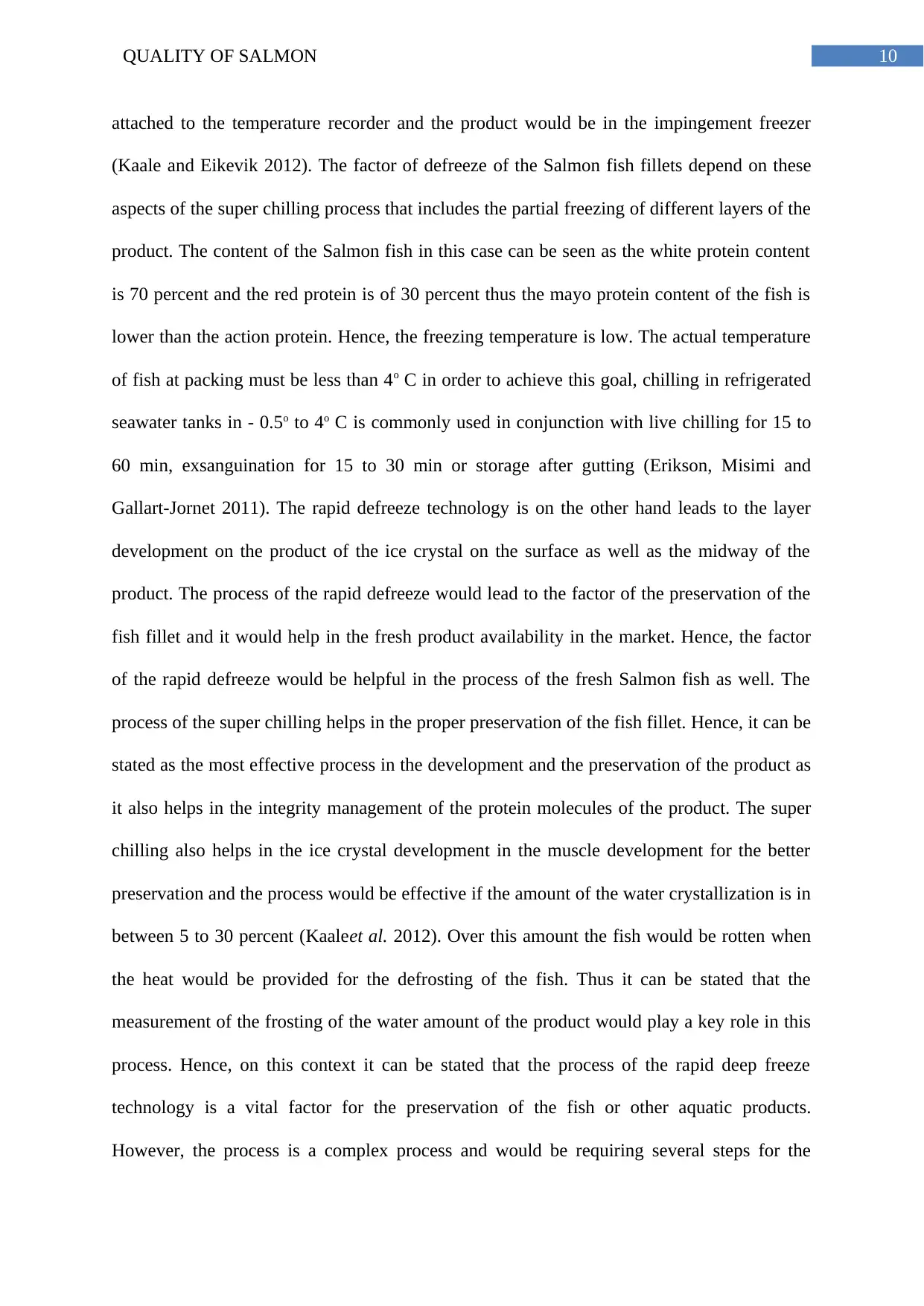
10QUALITY OF SALMON
attached to the temperature recorder and the product would be in the impingement freezer
(Kaale and Eikevik 2012). The factor of defreeze of the Salmon fish fillets depend on these
aspects of the super chilling process that includes the partial freezing of different layers of the
product. The content of the Salmon fish in this case can be seen as the white protein content
is 70 percent and the red protein is of 30 percent thus the mayo protein content of the fish is
lower than the action protein. Hence, the freezing temperature is low. The actual temperature
of fish at packing must be less than 4o C in order to achieve this goal, chilling in refrigerated
seawater tanks in - 0.5o to 4o C is commonly used in conjunction with live chilling for 15 to
60 min, exsanguination for 15 to 30 min or storage after gutting (Erikson, Misimi and
Gallart-Jornet 2011). The rapid defreeze technology is on the other hand leads to the layer
development on the product of the ice crystal on the surface as well as the midway of the
product. The process of the rapid defreeze would lead to the factor of the preservation of the
fish fillet and it would help in the fresh product availability in the market. Hence, the factor
of the rapid defreeze would be helpful in the process of the fresh Salmon fish as well. The
process of the super chilling helps in the proper preservation of the fish fillet. Hence, it can be
stated as the most effective process in the development and the preservation of the product as
it also helps in the integrity management of the protein molecules of the product. The super
chilling also helps in the ice crystal development in the muscle development for the better
preservation and the process would be effective if the amount of the water crystallization is in
between 5 to 30 percent (Kaaleet al. 2012). Over this amount the fish would be rotten when
the heat would be provided for the defrosting of the fish. Thus it can be stated that the
measurement of the frosting of the water amount of the product would play a key role in this
process. Hence, on this context it can be stated that the process of the rapid deep freeze
technology is a vital factor for the preservation of the fish or other aquatic products.
However, the process is a complex process and would be requiring several steps for the
attached to the temperature recorder and the product would be in the impingement freezer
(Kaale and Eikevik 2012). The factor of defreeze of the Salmon fish fillets depend on these
aspects of the super chilling process that includes the partial freezing of different layers of the
product. The content of the Salmon fish in this case can be seen as the white protein content
is 70 percent and the red protein is of 30 percent thus the mayo protein content of the fish is
lower than the action protein. Hence, the freezing temperature is low. The actual temperature
of fish at packing must be less than 4o C in order to achieve this goal, chilling in refrigerated
seawater tanks in - 0.5o to 4o C is commonly used in conjunction with live chilling for 15 to
60 min, exsanguination for 15 to 30 min or storage after gutting (Erikson, Misimi and
Gallart-Jornet 2011). The rapid defreeze technology is on the other hand leads to the layer
development on the product of the ice crystal on the surface as well as the midway of the
product. The process of the rapid defreeze would lead to the factor of the preservation of the
fish fillet and it would help in the fresh product availability in the market. Hence, the factor
of the rapid defreeze would be helpful in the process of the fresh Salmon fish as well. The
process of the super chilling helps in the proper preservation of the fish fillet. Hence, it can be
stated as the most effective process in the development and the preservation of the product as
it also helps in the integrity management of the protein molecules of the product. The super
chilling also helps in the ice crystal development in the muscle development for the better
preservation and the process would be effective if the amount of the water crystallization is in
between 5 to 30 percent (Kaaleet al. 2012). Over this amount the fish would be rotten when
the heat would be provided for the defrosting of the fish. Thus it can be stated that the
measurement of the frosting of the water amount of the product would play a key role in this
process. Hence, on this context it can be stated that the process of the rapid deep freeze
technology is a vital factor for the preservation of the fish or other aquatic products.
However, the process is a complex process and would be requiring several steps for the
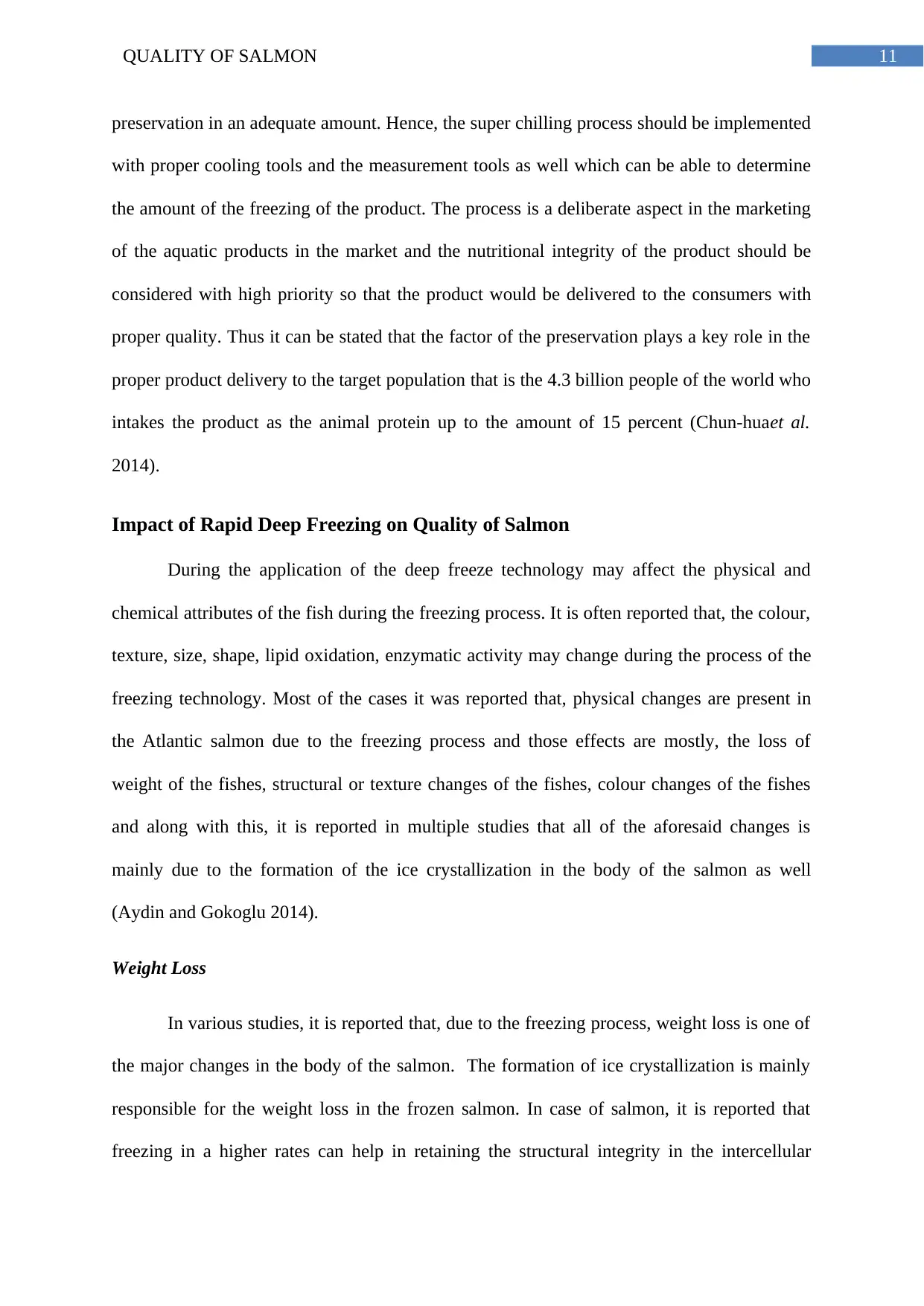
11QUALITY OF SALMON
preservation in an adequate amount. Hence, the super chilling process should be implemented
with proper cooling tools and the measurement tools as well which can be able to determine
the amount of the freezing of the product. The process is a deliberate aspect in the marketing
of the aquatic products in the market and the nutritional integrity of the product should be
considered with high priority so that the product would be delivered to the consumers with
proper quality. Thus it can be stated that the factor of the preservation plays a key role in the
proper product delivery to the target population that is the 4.3 billion people of the world who
intakes the product as the animal protein up to the amount of 15 percent (Chun-huaet al.
2014).
Impact of Rapid Deep Freezing on Quality of Salmon
During the application of the deep freeze technology may affect the physical and
chemical attributes of the fish during the freezing process. It is often reported that, the colour,
texture, size, shape, lipid oxidation, enzymatic activity may change during the process of the
freezing technology. Most of the cases it was reported that, physical changes are present in
the Atlantic salmon due to the freezing process and those effects are mostly, the loss of
weight of the fishes, structural or texture changes of the fishes, colour changes of the fishes
and along with this, it is reported in multiple studies that all of the aforesaid changes is
mainly due to the formation of the ice crystallization in the body of the salmon as well
(Aydin and Gokoglu 2014).
Weight Loss
In various studies, it is reported that, due to the freezing process, weight loss is one of
the major changes in the body of the salmon. The formation of ice crystallization is mainly
responsible for the weight loss in the frozen salmon. In case of salmon, it is reported that
freezing in a higher rates can help in retaining the structural integrity in the intercellular
preservation in an adequate amount. Hence, the super chilling process should be implemented
with proper cooling tools and the measurement tools as well which can be able to determine
the amount of the freezing of the product. The process is a deliberate aspect in the marketing
of the aquatic products in the market and the nutritional integrity of the product should be
considered with high priority so that the product would be delivered to the consumers with
proper quality. Thus it can be stated that the factor of the preservation plays a key role in the
proper product delivery to the target population that is the 4.3 billion people of the world who
intakes the product as the animal protein up to the amount of 15 percent (Chun-huaet al.
2014).
Impact of Rapid Deep Freezing on Quality of Salmon
During the application of the deep freeze technology may affect the physical and
chemical attributes of the fish during the freezing process. It is often reported that, the colour,
texture, size, shape, lipid oxidation, enzymatic activity may change during the process of the
freezing technology. Most of the cases it was reported that, physical changes are present in
the Atlantic salmon due to the freezing process and those effects are mostly, the loss of
weight of the fishes, structural or texture changes of the fishes, colour changes of the fishes
and along with this, it is reported in multiple studies that all of the aforesaid changes is
mainly due to the formation of the ice crystallization in the body of the salmon as well
(Aydin and Gokoglu 2014).
Weight Loss
In various studies, it is reported that, due to the freezing process, weight loss is one of
the major changes in the body of the salmon. The formation of ice crystallization is mainly
responsible for the weight loss in the frozen salmon. In case of salmon, it is reported that
freezing in a higher rates can help in retaining the structural integrity in the intercellular
⊘ This is a preview!⊘
Do you want full access?
Subscribe today to unlock all pages.

Trusted by 1+ million students worldwide
1 out of 38
Your All-in-One AI-Powered Toolkit for Academic Success.
+13062052269
info@desklib.com
Available 24*7 on WhatsApp / Email
![[object Object]](/_next/static/media/star-bottom.7253800d.svg)
Unlock your academic potential
Copyright © 2020–2025 A2Z Services. All Rights Reserved. Developed and managed by ZUCOL.
